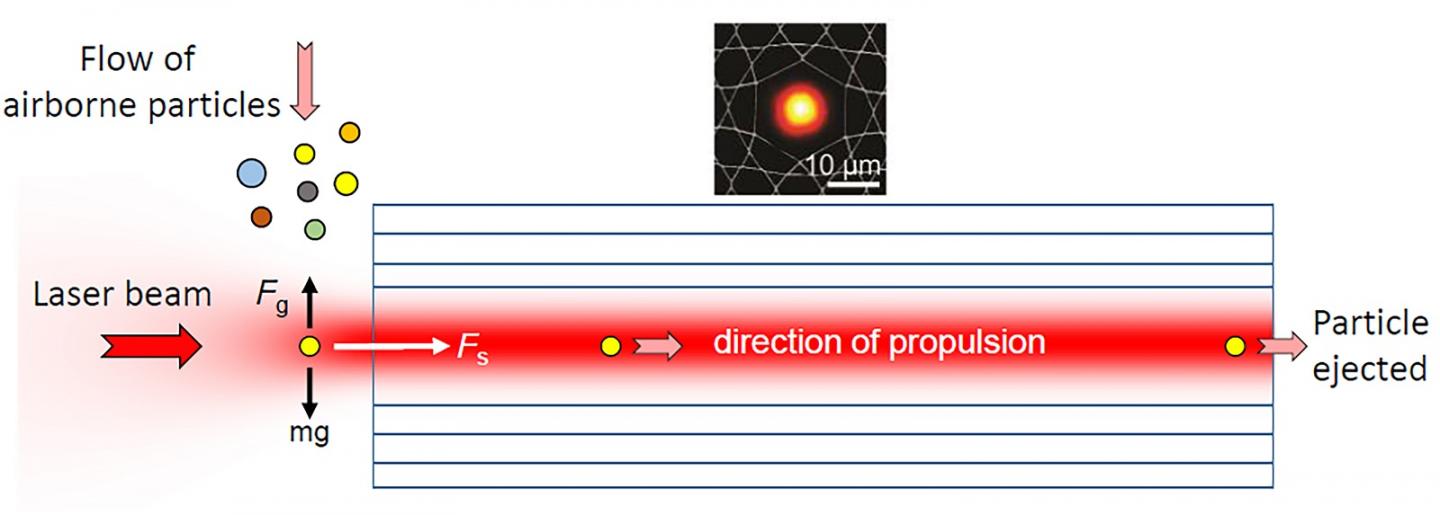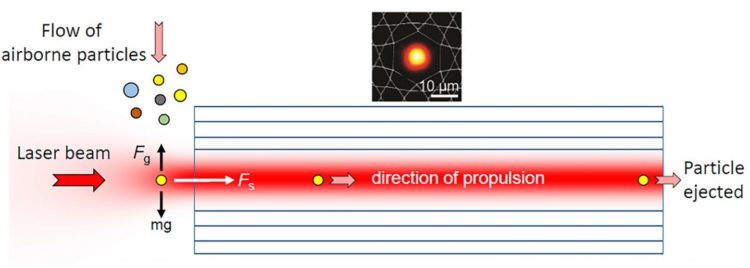Technique uses laser to capture and propel particles into a hollow fiber for analysis

Credit: Philip Russell, Max Planck Institute for the Science of Light
A new technique for continuously monitoring both the size and optical properties of individual airborne particles could offer a better way to monitor air pollution. It is especially promising for analyzing fine particulate matter measuring less than 2.5 microns (PM2.5), which can reach deep into the lungs and cause health problems.
“Air pollution has become an essential problem in many countries,” said research team leader Shangran Xie from the group of Prof. Philip Russell at Max Planck Institute for the Science of Light in Germany. “Since our setup is very simple and compact, it should be possible to turn it into a table-top device for continuously monitoring airborne PM2.5 in urban areas and industrial sites.”
In The Optical Society (OSA) journal Optics Express, the researchers describe how they used optical forces to automatically capture particles in the air and propel them into a hollow core fiber for analysis. The approach overcomes several limitations of existing methods by offering highly reproducible, real-time results and an unlimited device lifetime.
“The most unique feature of our technique is that it can count the number of particles — which is related to the level of pollution — while simultaneously providing detailed real-time information on particle size distribution and chemical dispersion,” said Xie. “This additional information could be useful for fast and continuous pollution monitoring in sensitive areas, for example.”
Trapping particles with light
For the new analysis approach, airborne particles are trapped inside a laser beam by optical forces and propelled forwards by radiation pressure. The trapping force is strong enough to overcome the gravitational force acting on very small particles such as PM2.5 and automatically aligns the particles with a hollow-core photonic crystal fiber. These special fibers feature a central core that is hollow and surrounded by a glass microstructure that confines light inside the fiber.
Once aligned, the laser light propels the particle into the fiber, causing the laser light inside the fiber to scatter and createe a detectable reduction in the fiber transmission. The researchers developed a new signal processing algorithm to retrieve useful information from the particle-scattering data in real-time. After detection, the particle simply ejects from the fiber without degrading the device.
“The transmission signal from the fiber also lets us measure time-of-flight, which is the time the particle takes to travel through the fiber,” said Abhinav Sharma, the doctoral student working on this project. “The drop in fiber transmission together with the time-of-flight information allow us to unambiguously calculate the particle size and refractive index. The refractive index can assist in identifying the particle material because this optical property is already known for most common pollutants.”
Precision measurements
The researchers tested their technique using polystyrene and silica particles of several different sizes. They found that the system could precisely separate particle types and could measure the 0.99-micron silica particle with a resolution as small as 18 nanometers.
The researchers plan to test the system’s ability to analyze particles which are more commonly found in the atmosphere. They also want to demonstrate the technique’s ability to perform measurements in liquid, which would be useful for water pollution monitoring. They have filed a patent on this technique and plan to continue to develop prototype devices, such as ones that could be used to monitor air pollution outside the lab.
###
Paper: A. Sharma, S. Xie, R. Zeltner, P. St.J. Russell, On-the-fly particle metrology in hollow-core photonic crystal fibre, Opt. Express, 27, 24, 34496-34504 (2019).
DOI: https:/
About Optics Express
Optics Express reports on scientific and technology innovations in all aspects of optics and photonics. The bi-weekly journal provides rapid publication of original, peer-reviewed papers. It is published by The Optical Society (OSA) and led by Editor-in-Chief James Leger of the University of Minnesota, USA. Optics Express is an open-access journal and is available at no cost to readers online at OSA Publishing.
About The Optical Society
Founded in 1916, The Optical Society (OSA) is the leading professional organization for scientists, engineers, students and business leaders who fuel discoveries, shape real-life applications and accelerate achievements in the science of light. Through world-renowned publications, meetings and membership initiatives, OSA provides quality research, inspired interactions and dedicated resources for its extensive global network of optics and photonics experts. For more information, visit osa.org.
Media Contact
Charles Blue
[email protected]
Original Source
https:/
Related Journal Article
http://dx.




